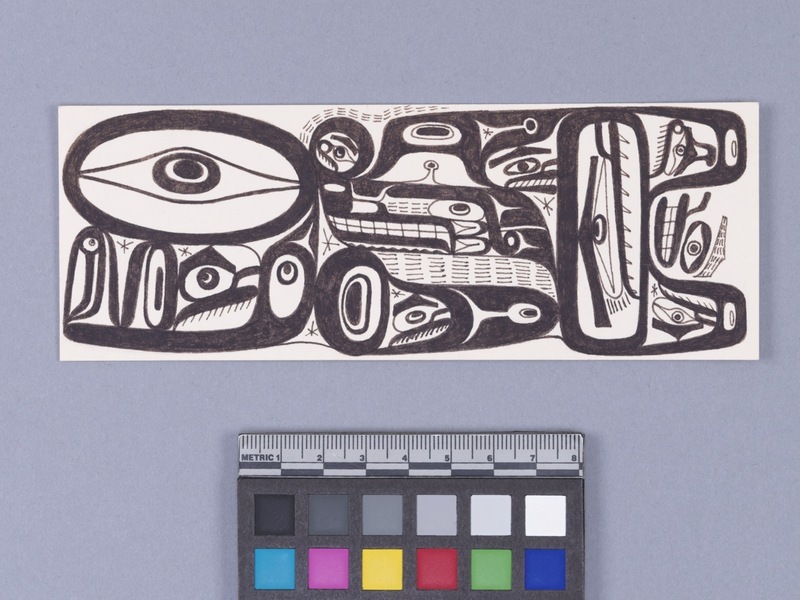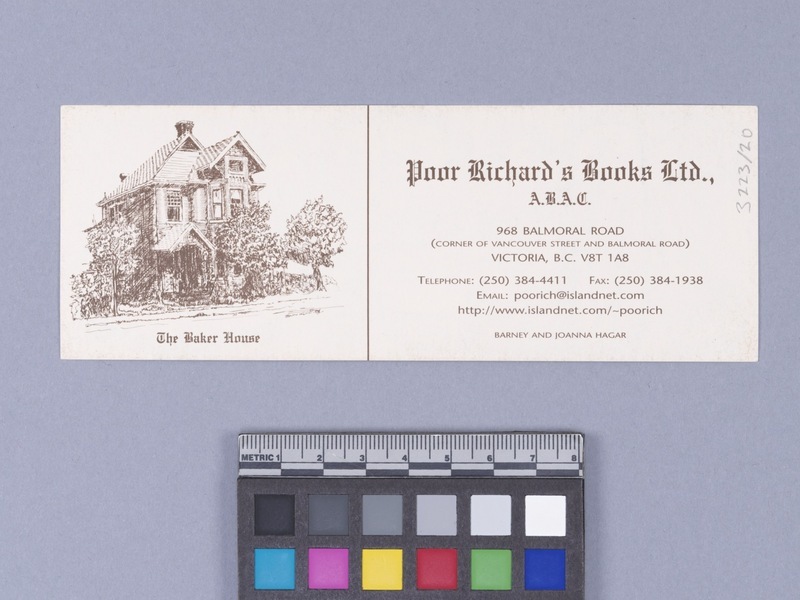Drawing Item Number: 3223/20 from the MOA: University of British Columbia


Description
A drawing on an off-white bookmark. The front-side is a horizontally oriented, hand-drawn image of a killer whale in black ink. The whale's head is comprised of an exaggerated eye-shape, and a lower jaw decorated with two stars and one smaller creature with an eye and teeth. Air exits from a blowhole at the back of the whale's head. The body of the whale is decorated with stripe patterns, four stars, and three creatures. The whale's tail is decorated with three small creatures and one star in the bottom tail fluke. A creature with an eye and square teeth is drawn between the two tail flukes. The reverse-side of the bookmark is machine-printed in brown ink. On the left half is an image of a house surrounded by trees with the text "The Baker House" printed below. The right half of the bookmark lists commercial information including the bookstore's name, "Poor Richards Books Ltd."
History Of Use
These 62 small works (3223/1-62) comprise a collection of drawings in pencil, ink, pencil crayon, and felt pen made by the artist between the years 1968 and 2015. During that period the artist has identified himself by the following names: Ron Hamilton; Hupquatchew; Ki-ke-in; Kwayatsapalth; Chuuchkamalthnii; and Haa’yuups. The drawings are, for the most part, applied to the backs of bookmarks acquired from a range of bookshops; some are applied to other pieces of paper or cutouts from his earlier silkscreen prints. Many of the images represent killer whales, often in conjunction with accoutrements and symbols of Nuu-chah-nulth whaling. The juxtaposition of bookmark and representation of Nuu-chah-nulth himwits’a, or narrative, is a deliberate and meaningful placement of two distinct knowledge systems in relationship with one another. Ephemeral drawings like these were not created for the market; the artist has long made them for himself and sometimes as gifts for relatives and friends; they are a way of sharing his knowledge and experience about Nuu-chah-nulth ways of knowing, thinking about, and being in this world; they are expressive of what he calls kiitskiitsa: marks made with intention.
Item History
- Made by Ron Hamilton (Maker) in British Columbia, Canada between 1968 and 2015
- Owned by Ron Hamilton before November 8, 2016
- Received from Museum of Anthropology Acquisitions Budget (Funding source), Michael O'Brian Family Foundation (Funding source) and Ron Hamilton (Seller) on November 18, 2016
What
- Name
- Drawing
- Identification Number
- 3223/20
- Type of Item
- drawing
- Overall
- height 6.0 cm, width 16.5 cm
Who
- Culture
- Nuu-chah-nulth: Hupacasath
- Creator
- Ron Hamilton (Maker)
- Previous Owner
- Ron Hamilton
- Received from
- Museum of Anthropology Acquisitions Budget (Funding source), Michael O'Brian Family Foundation (Funding source) and Ron Hamilton (Seller)
Where
- Holding Institution
- MOA: University of British Columbia
- Made in
- British Columbia, Canada
When
- Creation Date
- between 1968 and 2015
- Ownership Date
- before November 8, 2016
- Acquisition Date
- on November 18, 2016
Other
- Item Classes
- works on paper
- Condition
- good
- Current Location
- Case 9
- Accession Number
- 3223/0020